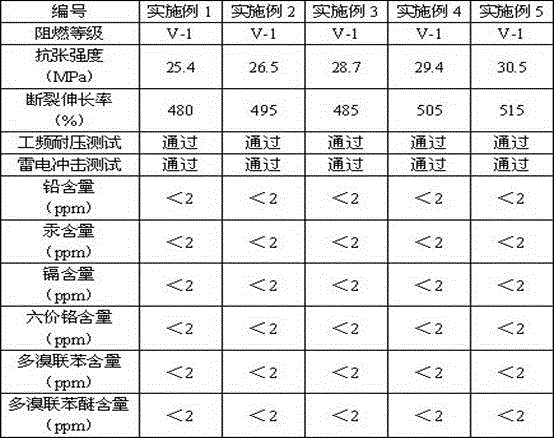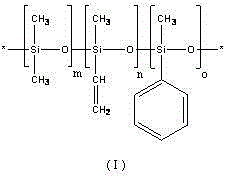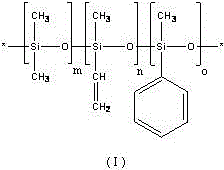Modified bus bar heat-shrinkable tube and preparation method thereof
A heat-shrinkable tube and busbar technology, applied in the field of modified busbar heat-shrinkable tube and its preparation, can solve the problems of poor insulation performance, difficult construction, short service life, etc., and achieve the effect of harmless to human body
- Summary
- Abstract
- Description
- Claims
- Application Information
AI Technical Summary
Problems solved by technology
Method used
Image
Examples
Embodiment 1
[0023] Example 1: Production of heat-shrinkable tubes for modified busbars.
[0024] (1) Weigh 10 kg of low-density polyethylene, 50 kg of olefin-methyl acrylate copolymer, methyl vinyl phenyl silicone rubber (the mole fraction of vinyl is 5%, and the mole fraction of phenyl is 10% ) 5 kg, 3 kg of melamine, 0.5 kg of nano-active calcium carbonate (with a particle size of 25 nm), 0.5 kg of nano-silicon dioxide (with a particle size of 10 nm) and 0.5 kg of dibutyl hydroxytoluene, and mix them uniformly to obtain a premix ;
[0025] (2) Mix and granulate the premix obtained in step (1) on a twin-screw extruder equipped with an internal mixer, and extrude it into a pipe on a single-screw extruder;
[0026] (3) The tube obtained in step (2) was radiated and cross-linked under the condition of 120 kGy, then heated at 150°C to expand twice, and quenched and formed to obtain a modified busbar heat-shrinkable tube.
Embodiment 2
[0027] Example 2: Production of heat-shrinkable tubes for modified busbars.
[0028] (1) Weigh 40 kg of low-density polyethylene, 80 kg of olefin-methyl acrylate copolymer, methyl vinyl phenyl silicone rubber (the mole fraction of vinyl is 15%, and the mole fraction of phenyl is 30% ) 10 kg, 8 kg of melamine, 5 kg of nano-active calcium carbonate (with a particle size of 100 nm), 5 kg of nano-silica (with a particle size of 50 nm) and 5 kg of dibutyl hydroxytoluene, and mix them uniformly to obtain a premix ;
[0029] (2) Mix and granulate the premix obtained in step (1) on a twin-screw extruder equipped with an internal mixer, and extrude it into a pipe on a single-screw extruder;
[0030] (3) The tube obtained in step (2) was radiated and cross-linked under the condition of 150 kGy, then heated at 150°C to expand twice, and quenched and formed to obtain a modified busbar heat-shrinkable tube.
Embodiment 3
[0031] Example 3: Production of heat-shrinkable tubes for modified busbars.
[0032] (1) Weigh 15 kg of low-density polyethylene, 55 kg of olefin-methyl acrylate copolymer, methyl vinyl phenyl silicone rubber (the mole fraction of vinyl is 5%, and the mole fraction of phenyl is 10% ) 6 kg, 4 kg of melamine, 1 kg of nano-active calcium carbonate (with a particle size of 30 nm), 1 kg of nano-silica (with a particle size of 20 nm) and 1 kg of dibutyl hydroxytoluene, and mix them uniformly to obtain a premix ;
[0033] (2) Mix and granulate the premix obtained in step (1) on a twin-screw extruder equipped with an internal mixer, and extrude it into a pipe on a single-screw extruder;
[0034] (3) The tube obtained in step (2) was radiated and cross-linked under the condition of 120 kGy, then heated at 150°C to expand twice, and quenched and formed to obtain a modified busbar heat-shrinkable tube.
PUM
| Property | Measurement | Unit |
|---|---|---|
| Granularity | aaaaa | aaaaa |
| Granularity | aaaaa | aaaaa |
| Granularity | aaaaa | aaaaa |
Abstract
Description
Claims
Application Information
 Login to View More
Login to View More - R&D
- Intellectual Property
- Life Sciences
- Materials
- Tech Scout
- Unparalleled Data Quality
- Higher Quality Content
- 60% Fewer Hallucinations
Browse by: Latest US Patents, China's latest patents, Technical Efficacy Thesaurus, Application Domain, Technology Topic, Popular Technical Reports.
© 2025 PatSnap. All rights reserved.Legal|Privacy policy|Modern Slavery Act Transparency Statement|Sitemap|About US| Contact US: help@patsnap.com



